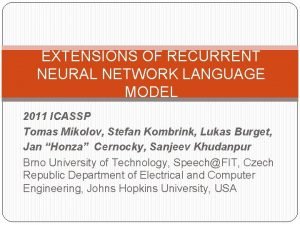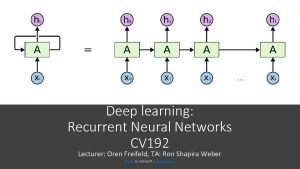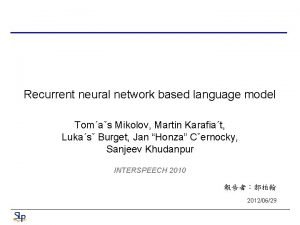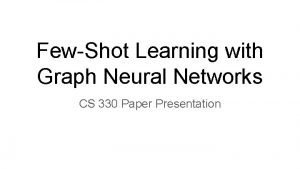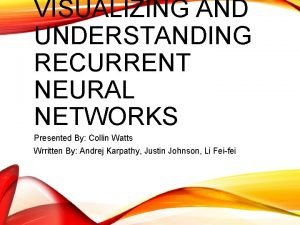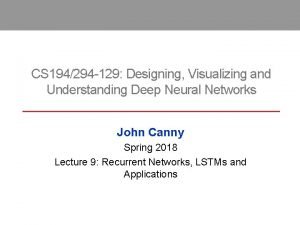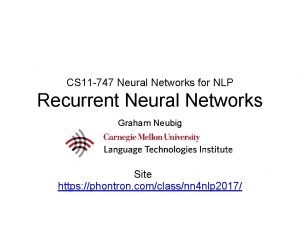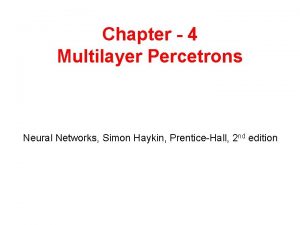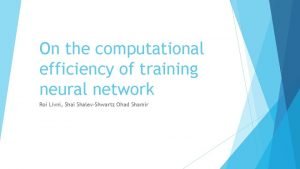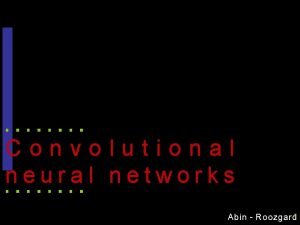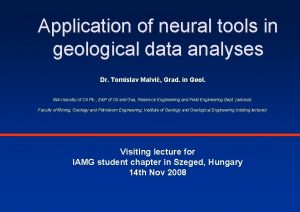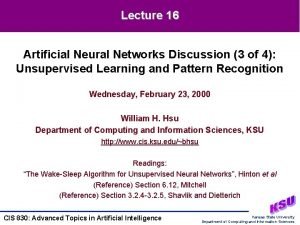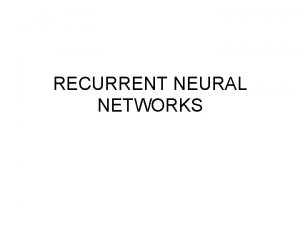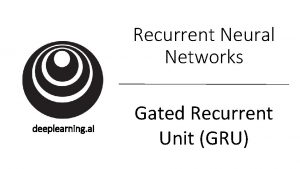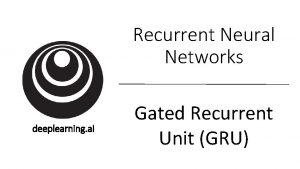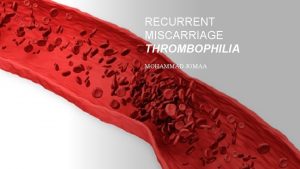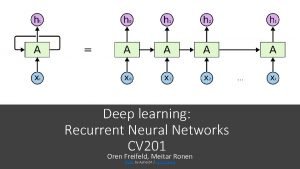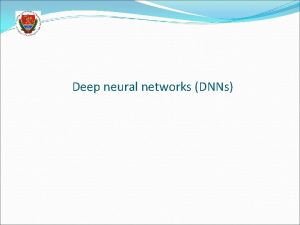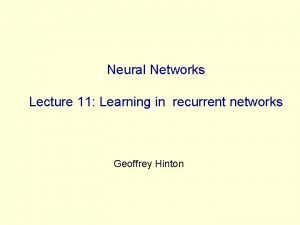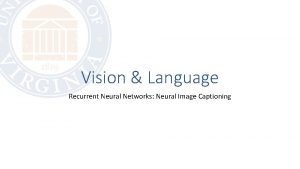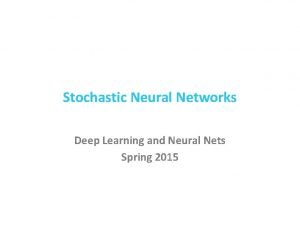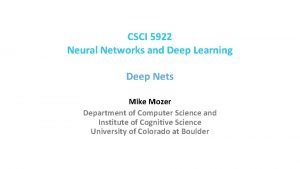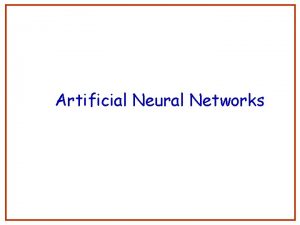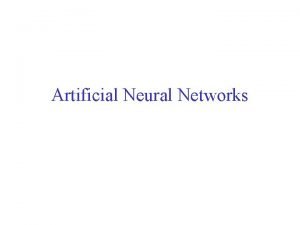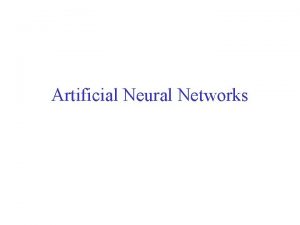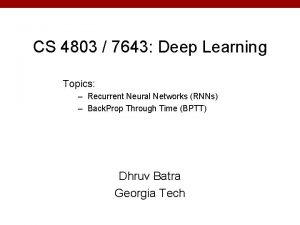Deep learning Recurrent Neural Networks CV 192 Lecturer











































![[http: //norman-ai. mit. edu/] [http: //norman-ai. mit. edu/]](https://slidetodoc.com/presentation_image_h/b16eb6c3a944e909f2dd9aa58b3bb47a/image-44.jpg)
![[http: //norman-ai. mit. edu/] [http: //norman-ai. mit. edu/]](https://slidetodoc.com/presentation_image_h/b16eb6c3a944e909f2dd9aa58b3bb47a/image-45.jpg)
![[http: //norman-ai. mit. edu/] [http: //norman-ai. mit. edu/]](https://slidetodoc.com/presentation_image_h/b16eb6c3a944e909f2dd9aa58b3bb47a/image-46.jpg)


- Slides: 48

Deep learning: Recurrent Neural Networks CV 192 Lecturer: Oren Freifeld, TA: Ron Shapira Weber Photo by Aphex 34 / CC BY-SA 4. 0

Contents • • Review of previous lecture – CNN Recurrent Neural Networks Back propagation through RNN LSTM

Example – Object recognition and localization [Andrej Karpathy Li Fei-Fei, (2015): Deep Visual-Semantic Alignments for Generating Image Descriptions]

MLP with one hidden layer [Lecun, Y. , Bengio, Y. , & Hinton, G. (2015)]

How big should our hidden layer be? https: //cs. stanford. edu/people/karpathy/convnetjs/demo/cl assify 2 d. html

Convolution • Discrete: kernel Convolution: matrix*kernel http: //deeplearning. net/software/theano/tutorial/conv_arithmetic. html

. CNN – Convolutional Layer Filters learned by Alex. Net (2012) 96 convolution kernels of size 11 x 3 learned by the first convolutional layer on the 224 x 3 input images (Image. Net) Krizhevsky, A. , Sutskever, I. , & Hinton, G. E. (2012).

. CNN – Pooling Layer • Reduce the spatial size of the next layer http: //cs 231 n. github. io/convolutional-networks/

. CNN – Fully connected layer • Usually the last layer before the output layer (e. g softmax)

. Feature Visualization • Visualizing via optimization of the input: Colah, et al. , "Feature Visualization", Distill, 2017.

Recurrent Neural Networks

Sequence modeling Examples: Image classification Image captioning Sentiment analysis http: //karpathy. github. io/2015/05/21 /rnn-effectiveness/ Machine translation Video frame-by-frame classification

DRAW: A recurrent neural network for image generation [Gregor, et al. , (2015) DRAW: A recurrent neural network for image generation]

. Recurrent Neural Networks vs Feedforward Networks

. Recurrent Neural Networks Gradient flow

. Recurrent Neural Networks

. Recurrent Neural Networks Truncated Back propagation “through time”: • Break every K steps. • Forward propagation stays the same. • Downside?

. Recurrent Neural Networks •

. Recall the vanishing gradient problem…

. Gradient behavior in RNN •

Vanishing / exploding gradient • [Example from: Goodfellow, I. , Bengio, Y. , Courville, A. , & Bengio, Y. (2016). Deep learning (Vol. 1). ]

. Vanishing / exploding gradient •

. Long Short Term Memory (LSTM) • [Hochreiter, S. , & Schmidhuber, J. (1997). Long short-term memory]

. LSTM vs regular RNN The repeating module in a standard RNN contains a single layer. http: //colah. github. io/posts/2015 -08 -Understanding-LSTMs/ The repeating module in an LSTM contains four interacting layers.

. LSTM • http: //colah. github. io/posts/2015 -08 -Understanding-LSTMs/

. LSTM – Gradient Flow Chen, G. (2016). A Gentle Tutorial of Recurrent Neural Network with Error Backpropagation

. Input gate • http: //colah. github. io/posts/2015 -08 -Understanding-LSTMs/

. (tanh) gate • http: //colah. github. io/posts/2015 -08 -Understanding-LSTMs/

. Forget Gate • http: //colah. github. io/posts/2015 -08 -Understanding-LSTMs/

. Output Gate • http: //colah. github. io/posts/2015 -08 -Understanding-LSTMs/

. LSTM • http: //colah. github. io/posts/2015 -08 -Understanding-LSTMs/

. LSTM Summary •

. Increasing model memory •

. Increasing model memory • Adding more hidden layers increases the model capacity while computation scales linearly. • Increases representational power via non-linearity.

. Increasing model memory • Adding depth through ‘time’. • Does not increase memory. • Increases representational power via non-linearity.

. Neural Image Caption Generation with Visual Attention [Xu et al. , (2015) Show and tell: A neural image caption generator]

. Neural Image Caption Generation with Visual Attention [Xu et al. , (2015) Show and tell: A neural image caption generator]

. Neural Image Caption Generation with Visual Attention [Xu et al. , (2015) Show and tell: A neural image caption generator]

. Neural Image Caption Generation with Visual Attention • Word generation conditioned on: • Context vector (CNN features) • Previous hidden state • Previously generated word [Xu et al. , (2015) Show and tell: A neural image caption generator]

Shakespeare http: //karpathy. github. io/2015/05/21/rnn-effectiveness/

Visualizing the predictions and the “neuron” firings in the RNN http: //karpathy. github. io/2015/05/21/rnn-effectiveness/

Visualizing the predictions and the “neuron” firings in the RNN http: //karpathy. github. io/2015/05/21/rnn-effectiveness/

Visualizing the predictions and the “neuron” firings in the RNN http: //karpathy. github. io/2015/05/21/rnn-effectiveness/
![http normanai mit edu [http: //norman-ai. mit. edu/]](https://slidetodoc.com/presentation_image_h/b16eb6c3a944e909f2dd9aa58b3bb47a/image-44.jpg)
[http: //norman-ai. mit. edu/]
![http normanai mit edu [http: //norman-ai. mit. edu/]](https://slidetodoc.com/presentation_image_h/b16eb6c3a944e909f2dd9aa58b3bb47a/image-45.jpg)
[http: //norman-ai. mit. edu/]
![http normanai mit edu [http: //norman-ai. mit. edu/]](https://slidetodoc.com/presentation_image_h/b16eb6c3a944e909f2dd9aa58b3bb47a/image-46.jpg)
[http: //norman-ai. mit. edu/]

. Summary • Deep learning is a field of machine learning that uses artificial neural network in order to learn representations in an hierarchical manner. • Convolutional neural achieved state-of-the-art results in the field of computer vision by • Reducing the number of parameters via shard weights and local connectivity. • Using an hierarchal model. • Recurrent neural network are used for sequence modelling. The vanishing gradient problem is address by a model called LSTM.

. Thanks!
 Deep forest: towards an alternative to deep neural networks
Deep forest: towards an alternative to deep neural networks Lecturer's name
Lecturer's name Rnn
Rnn Andrew ng lstm
Andrew ng lstm Efficient processing of deep neural networks pdf
Efficient processing of deep neural networks pdf Deep neural networks and mixed integer linear optimization
Deep neural networks and mixed integer linear optimization Extensions of recurrent neural network language model
Extensions of recurrent neural network language model Colah lstm
Colah lstm Karafia
Karafia Least mean square algorithm in neural network
Least mean square algorithm in neural network Few shot learning with graph neural networks
Few shot learning with graph neural networks Neural networks and learning machines
Neural networks and learning machines Visualizing and understanding recurrent networks
Visualizing and understanding recurrent networks Cs 231 n
Cs 231 n Deep learning vs machine learning
Deep learning vs machine learning Tony wagner's seven survival skills
Tony wagner's seven survival skills Visualizing and understanding convolutional neural networks
Visualizing and understanding convolutional neural networks Fat shattering dimension
Fat shattering dimension Neural network ib psychology
Neural network ib psychology Audio super resolution using neural networks
Audio super resolution using neural networks Convolutional neural networks for visual recognition
Convolutional neural networks for visual recognition Leon gatys
Leon gatys What is stride in cnn
What is stride in cnn Introduction to neural networks using matlab
Introduction to neural networks using matlab Neural networks for rf and microwave design
Neural networks for rf and microwave design 11-747 neural networks for nlp
11-747 neural networks for nlp Xor problem
Xor problem Sparse convolutional neural networks
Sparse convolutional neural networks On the computational efficiency of training neural networks
On the computational efficiency of training neural networks Tlu perceptron
Tlu perceptron Neural networks and fuzzy logic
Neural networks and fuzzy logic Introduction to convolutional neural networks
Introduction to convolutional neural networks Lmu cis
Lmu cis Convolutional neural networks
Convolutional neural networks Neuraltools neural networks
Neuraltools neural networks Predicting nba games using neural networks
Predicting nba games using neural networks The wake-sleep algorithm for unsupervised neural networks
The wake-sleep algorithm for unsupervised neural networks Audio super resolution
Audio super resolution Convolutional neural network alternatives
Convolutional neural network alternatives Physician associate lecturer
Physician associate lecturer Spe distinguished lecturer
Spe distinguished lecturer Teacher good afternoon
Teacher good afternoon Photography lecturer
Photography lecturer Lecturer in charge
Lecturer in charge Designation lecturer
Designation lecturer Designation of lecturer
Designation of lecturer Gcwak
Gcwak Lecturer name
Lecturer name Pearson lecturer resources
Pearson lecturer resources






